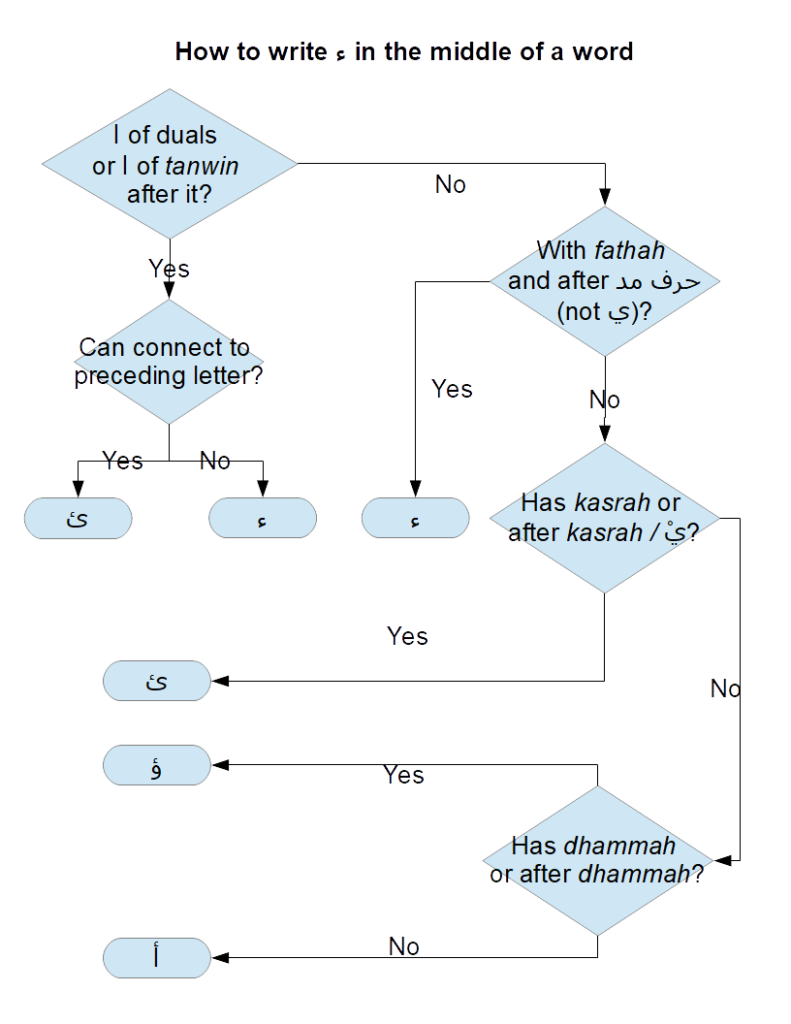السلام عليكم

Continuing from Shaykh Ibn Uthaymeen’s قواعد في الإملاء (Rules for Writing), we learn when to write the hamzah (ء) in its various forms.
The hamzah can occur in the:
- beginning of a word
- end of a word
- middle of a word
When hamzah occurs at the beginning of a word
In this case the hamzah is always written in the alif form (أ or إ). For example, in أُكْرِم أَبُوْكَ إكْرامًا (your father was honored an honoring), all three words have the hamzah in the beginning.
When hamzah occurs at the end of a word
At the end of the word, hamzah is:
- sometimes written as itself (ء):
- If the letter before it has a waw with dhammah and a shaddah (وًّ). For example: التَبَوُّءُ
- If the letter before it has sukun on it. For example: دِفْء (warmth), قُرُوْء (menstrual cycles), دُعاء (invocation), and مَلِيْء (filled)
- An exception would be if the hamzah is nasb-ized with tanwin and it is possible to connect it to the silent letter. It would then be written over a ي. For example: خِطْئًا كَبِيرًا and شَيْئًا مَذْكُوْرًا
- sometimes written on a letter that resembles the vowel on the letter preceding it
- Upon a waw (و), as in التَواطُؤُ
- Upon an alif (ا), as in قَرَأَ
- Upon a yaa (ي) as in قُرِئَ
When hamzah is in the middle of a word
In this case, it can be written:
- On an alif (أ)
- When it has sukun after a letter with fathah, as in رَأْس
- When it has a fathah, after a letter with either fathah or a “sound” letter with sukun, as in سَأَلَ and يَسْأَلُ
- Note: a “sound” letter is a letter that is not of the three “defective” letters (ا – و – ي)
- The same rule is followed if the fath-ized hamzah or the letter before it has a shaddah on it, as in تَذَأَّبَ or تَبَوّاها
- On a waw (ؤ)
- When it has fathah or sukun after a letter with dhammah, as in مُؤَلِّف and لُؤُلُؤ
- When it has dhammah after a letter that has dhammah, fathah or sukun, as in شُؤُوْن (affairs), يَؤُمُّ (he leads) or مَرْؤُوس (some write it as مَرْءُوْس)
- When two و’s follow each other there are several approaches for writing it (taking مَرْؤُوس as an example):
- Writing ء on the line by itself, as in مَرْءُوْس (or as ئ if it can connect to the letter before, as in شُئُون)
- Writing it on a و as in مَرْؤُوس
- Writing it on the second و and dropping the first, as in مَرْؤس
- When two و’s follow each other there are several approaches for writing it (taking مَرْؤُوس as an example):
- On a yaa (ئ)
- Whenever it has a kasrah, as in سَئِم, or سُئِلَ (he was asked), أسْئِلَة (questions) and مَسائِل (matters)
- If it has fathah, dhammah or sukun after (a letter with a kasrah or silent ي), as in مِئَة (a hundred), فِئُوْن (groups), بِئْر (well), مُسِيْئان (two who harm), مُسِيْئُوْن (ones who harm)
- ِAs itself (ء)
- When it has a fathah and is after an elongated sound (حَرف مَدّ) that is not a ي (i.e. a ا or و), as in تَساءَل (ask one’s self), مُرُوءَة (chivalry), and سَمَوْءَل (name of a person)
- Or the alif used for duals comes after it but it’s not possible to connect the ء to what’s before it, as in جُزْءان (two parts)
- If it is possible to connect the ء to what’s before it, then it’s written on a ي, as in خَطَئان (two mistakes)
- Note: Shaykh Uthaymeen رحمه الله did not explicitly mention it, but the same rule is applied if the alif of tanwin follows as well, as in خِطْئًا (can connect the ء to what’s before it) and جُزْءًا (cannot connect it)
To simply things, below is an image summarizing the rules we’ve covered:

Until next time, السلام عليكم
Like this post? Simply enter your e-mail and click “Yes, include me!” for updates
Leave a Reply